By Brianna Vincent
I thoroughly enjoyed my part of working on Edwin Harris’s sketchbooks, one of the interesting parts of the experience being how it became an exercise in sustained déjà vu. The déjà vu would leave me carefully leafing through the pages and wondering if I had seen this building, this tree, this beach, or this angle of the river before. Or if it was my imagination! And I was merely remembering the image from the last time I studied it. Trying to work backwards and forwards through the sketchbooks, each direction arbitrary, to compare a sketch to the others felt increasingly inefficient. Physically, the delicacy of the pages meant that holding a page open on a sketch while trying to look through and compare the other pages was a slow and awkward process. Electronically, keeping both sketchbooks on screen beside each other as I scrolled up and down each one made me paranoid that I was still missing connections within the individual sketchbooks. Which is what prompted the idea that what we really needed was a physical copy that I could rearrange at will, to be able to grab a picture and hold it up to its possible partner, not bound by how Edwin had filled his sketchbooks in. And so I printed out our photos of the sketchbooks and cut them into their individual sketches, noting the sketchbook and page number on the back and got to work in what essentially became an Edwin Harris themed game of Snap; matching landscapes with other landscapes, piling together buildings, gathering rivers, and collecting beaches, stacking trees and so on as I went from monopolising the floor with the spread out sketches to having little compact piles.
Several connections soon became apparent even as I was collecting them together, that we had four sketches of the Nelson seashore all with Fifeshire rock visible. That there were three different pieces that Edwin had done on the same area of Maitai hop fields! Which we hadn’t realised were connected because we’d never brought them close enough together to see it was the same area from different distances and varying levels of detail.
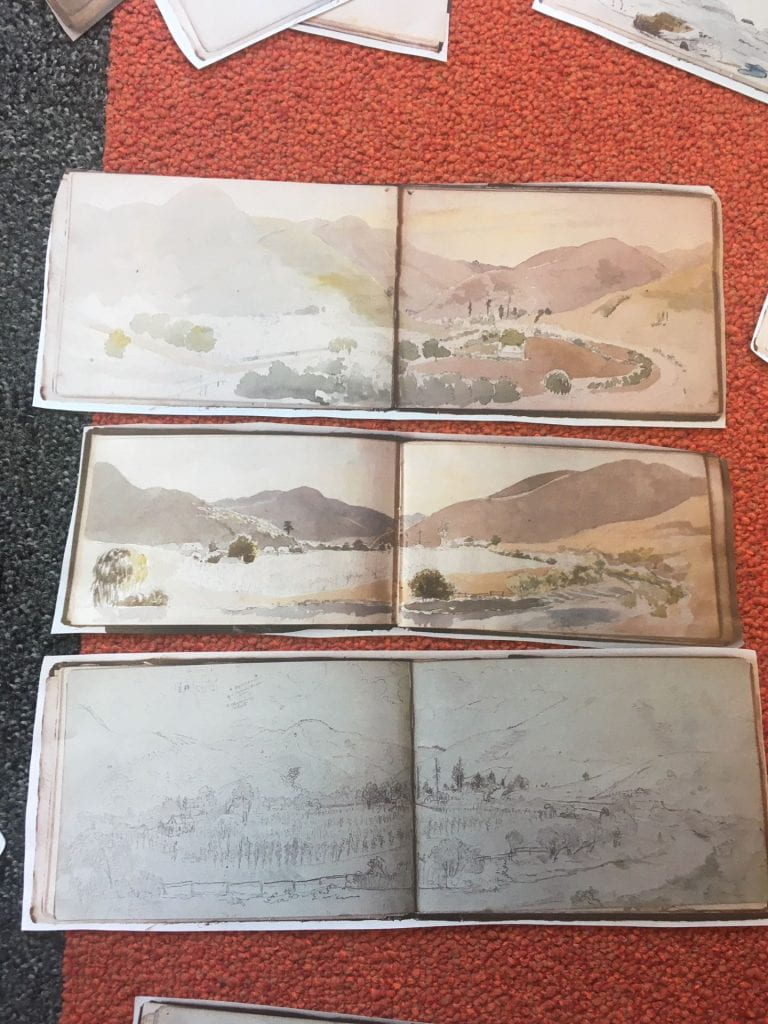
However, what I was most interested in, at least initially, was the tree that started me on this little obsessive journey. I had been looking for a landscape or a tree that might be a match for a landscape that Edwin captioned with a sentence that we can’t make out but which features a large tree, coloured in blue, as one of its focal points on pages 57-58 of the Cranstone sketchbook. I didn’t find a tree that matched the blue tree but what did capture my attention was the distinctive tree in a sketch that Edwin captions ‘Pukatea tree” and “Maitai River’’
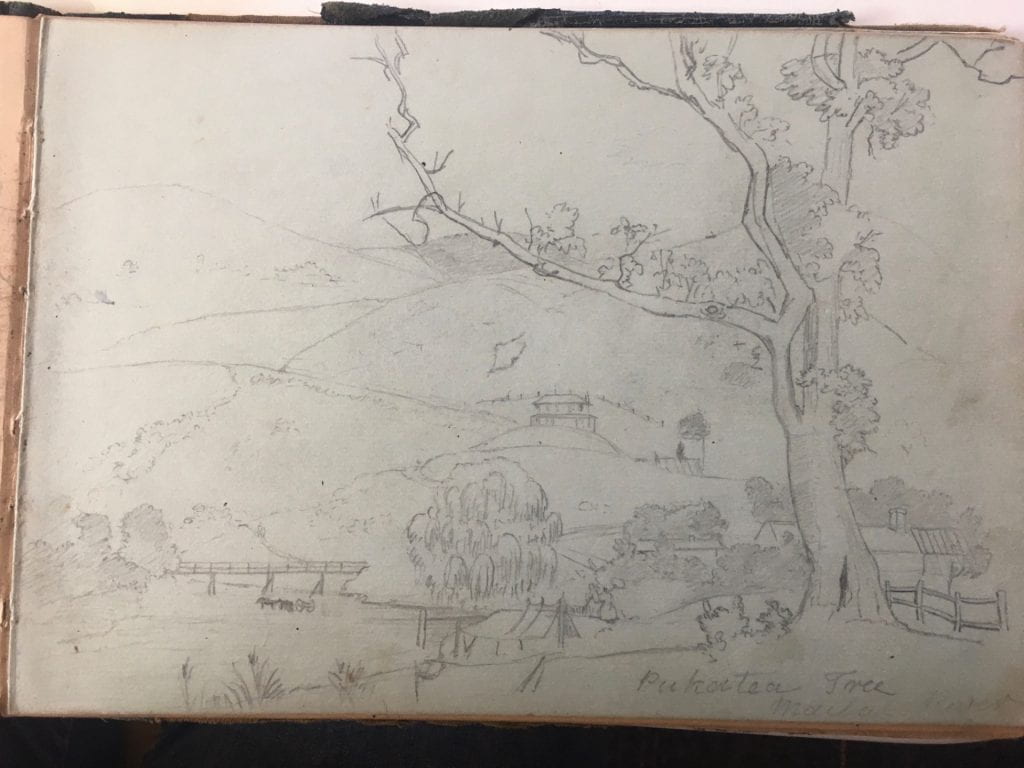
The way the tree bends to the left of the sketch, the angles going across and up as a branch splits into two, and its spindly thin form stuck in my mind, and feeling that déjà vu I had turned the pages of the sketchbook and found the tree again. From the opposite side of the scene, there was the Pukatea tree by the river.
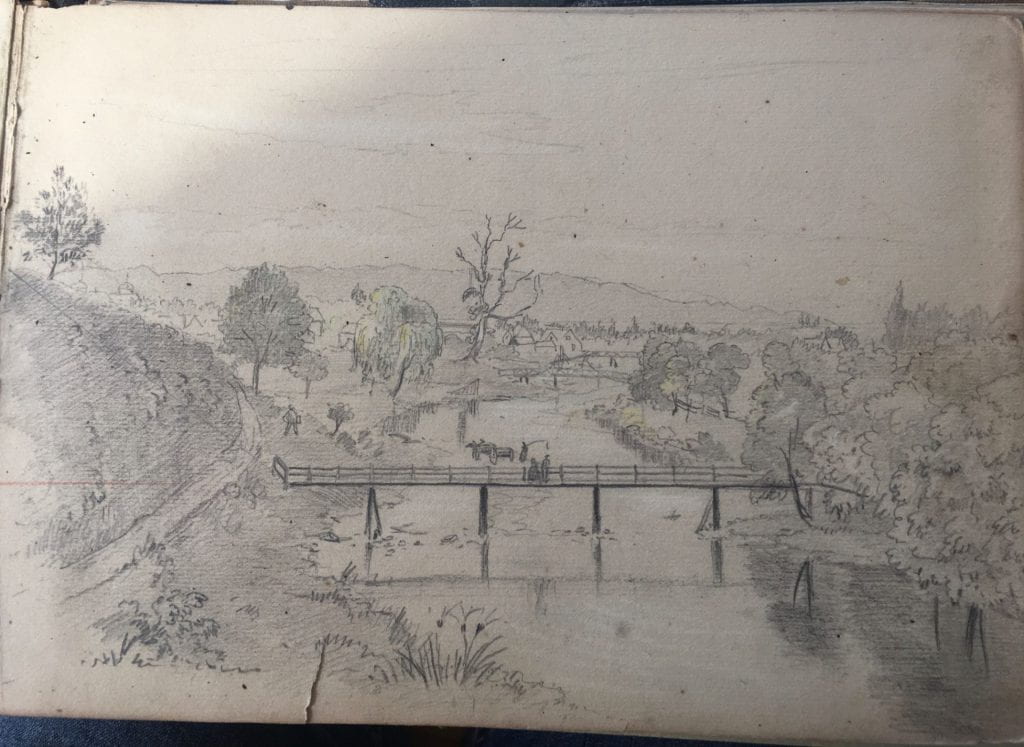
There was the river, the same bridge, the Pukatea tree. The pictures were from opposite sides of the same scene, one looking from the tree over to the hills and house. The other, looking from somewhere on that hill looking over to the Pukatea tree and town. Going back and forth from pages 8 and 14 in the Briant sketchbook, trying to be sure, was the moment that I wanted to physically place these side by side and find any others that might add more angles to this scene. Later, with my printed collection of sketches I was able to do so:

Then, looking through my new pile of river pictures, I scanned for the Pukatea tree, the house, the hill, the river, looking to see if Edwin did any more sketches to add to the 3D scene I was trying to create in my head. And I found this watercolour in the Cranstone sketchbook, spotting in the distance the spindly arms of the Pukatea tree poking out of the surrounding bush. Looking back at the other sketch, it had the same order of three trees; a bushy tree (for the lack of a better name), a willow, and the Pukatea. This watercolour was done closer to the water, somewhere near or on part of the bank itself, at a point would result in the new angle of the trees.
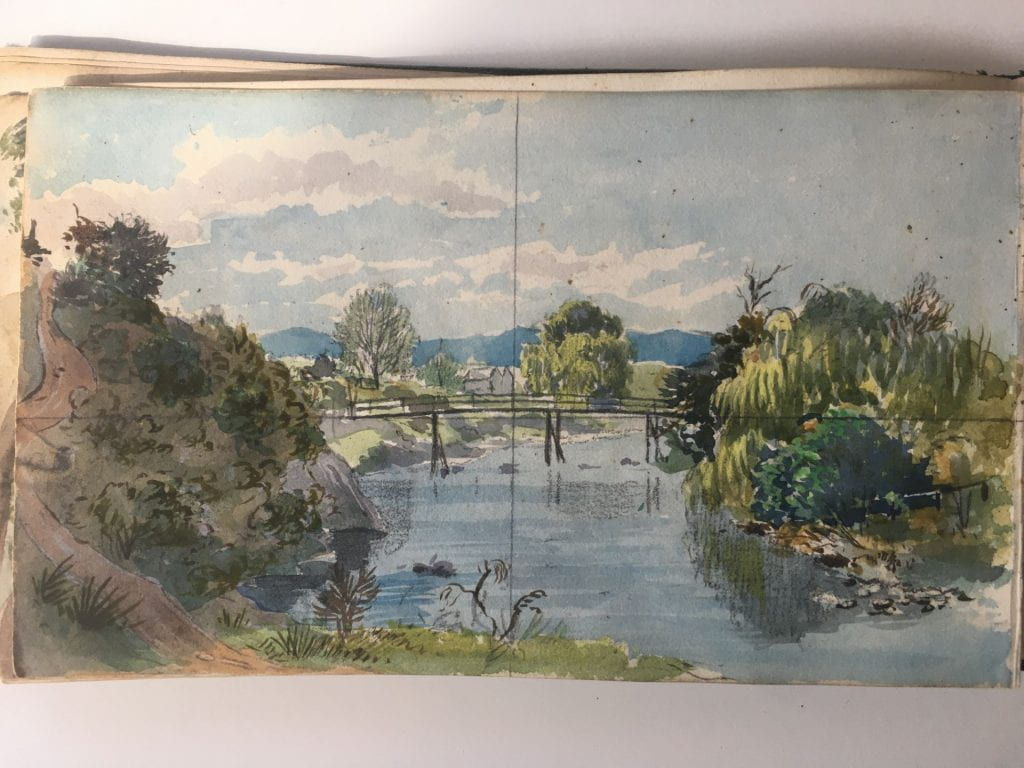

Looking for this pattern of trees by the river and bridge led me to this sketch in the Cranstone sketchbook, with less meticulous detail than the others but the same pattern, another new angle and distance to add to the mental picture. The incomplete bridge in the forefront asking the question if the bridge wasn’t finished at the time of the sketch, making it predate several of the others, or if Edwin just didn’t complete those details.
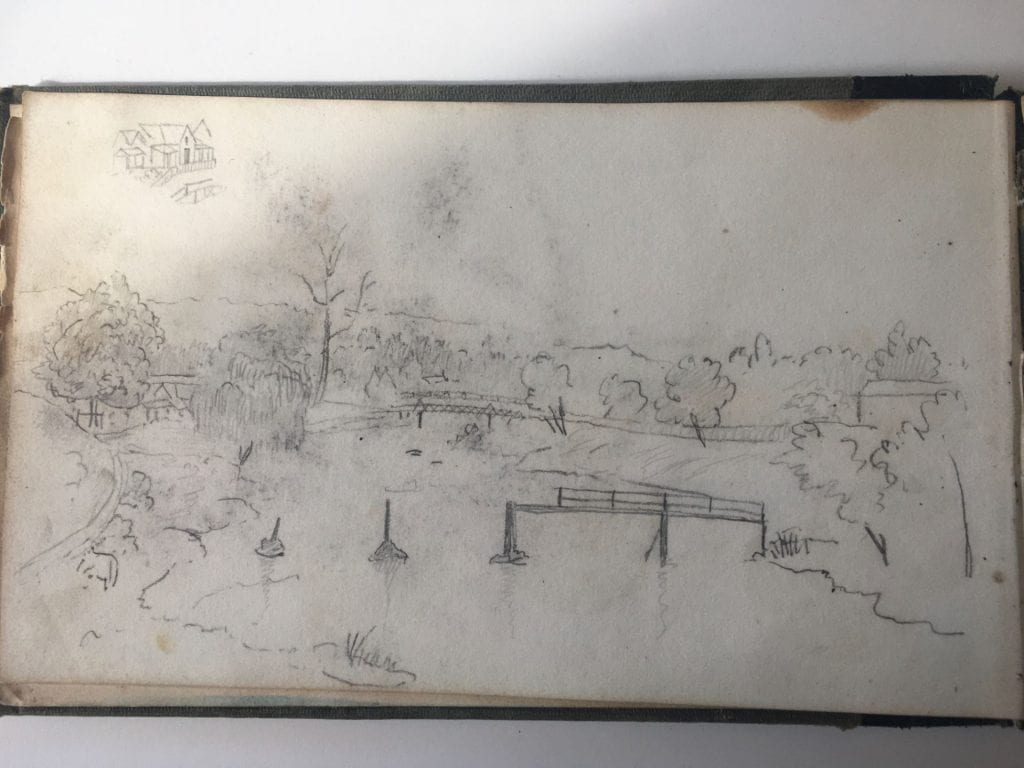
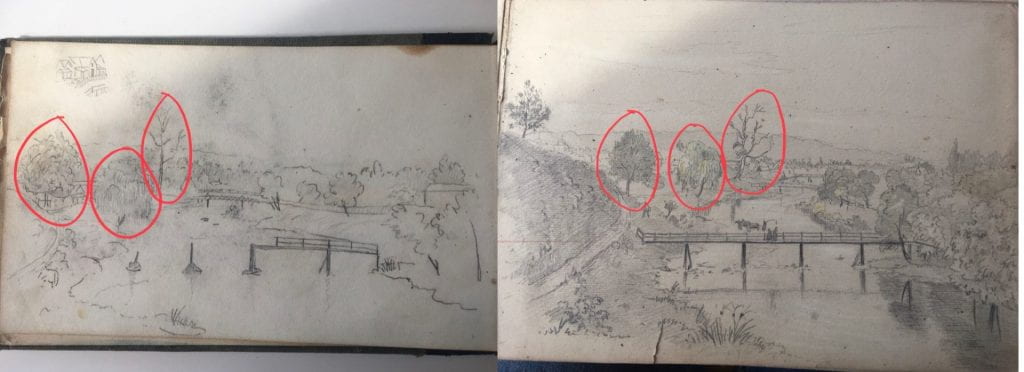
Finally, there was this watercolour, though I was unable to spot the pattern of trees, the picture appears to show a walkway beside the river. There’s a bridge painted in stark white over the river in the distance and a white house amid the hills that looks similar to the house pictured in the Pukatea sketch. Could this be the same scene from, perhaps from another angle?
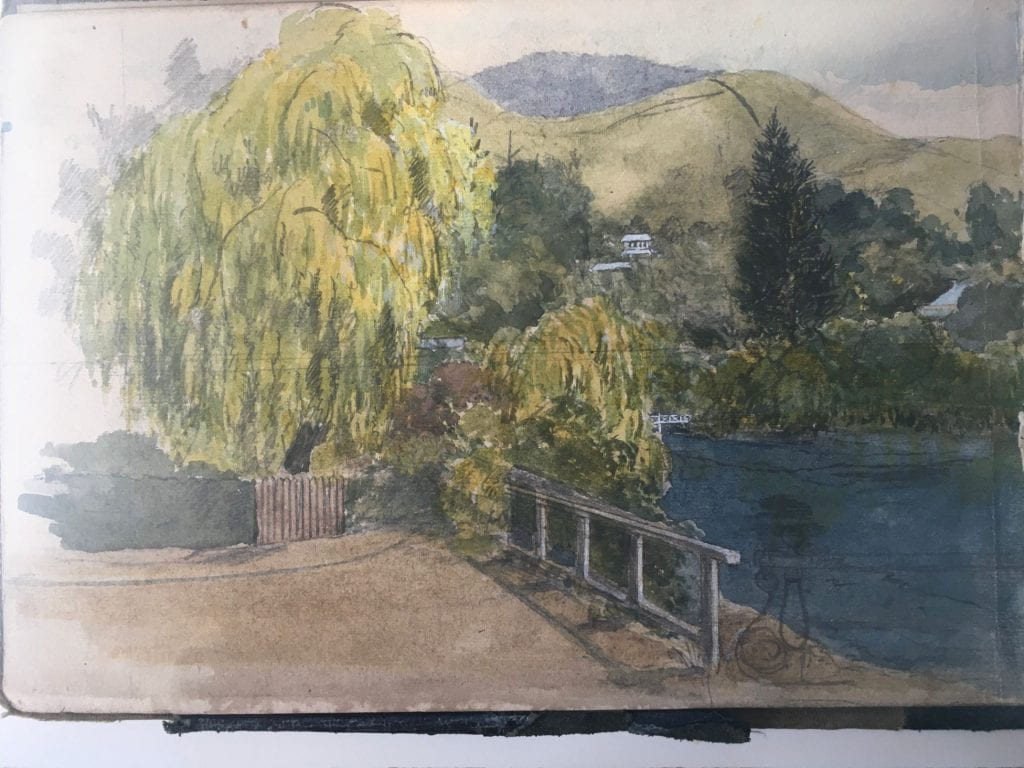
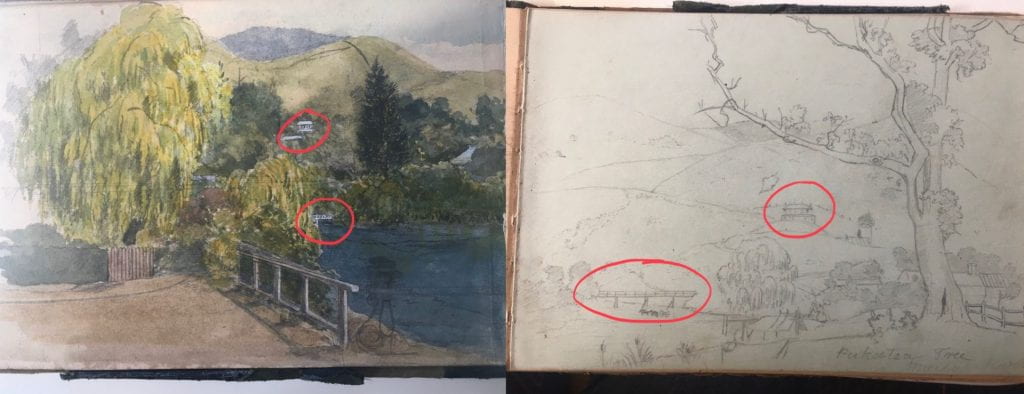
Putting these together, it feels like putting together a puzzle where I don’t know if everything exactly fits and turning around the picture in my head, the angle or position Edwin must have drawn from sometimes escapes me. But assembling the snapshots gives a glimpse into Edwin’s travels around the area, giving himself different angles and distances to draw and paint the familiar scene that must have appealed to him.
The photo archives of Nelson Provincial Museum have been helpful in identifying some of the buildings and places in the sketchbooks, as well as historical website The Prow and help from Nelsonians, and so I looked through photos of Maitai river at the end of my search through Edwin’s piles. It’s a search that will give you many many pages of results and I wasn’t sure what exactly I was hoping for, how close of a match to anything I was likely to find, but then I felt that rush of recognition. I spotted a photo called simply ‘Maitai – Miss Richardson’s house on right’, and here, with its distinctive angles of its branches, was Edwin’s Pukatea tree. Snap
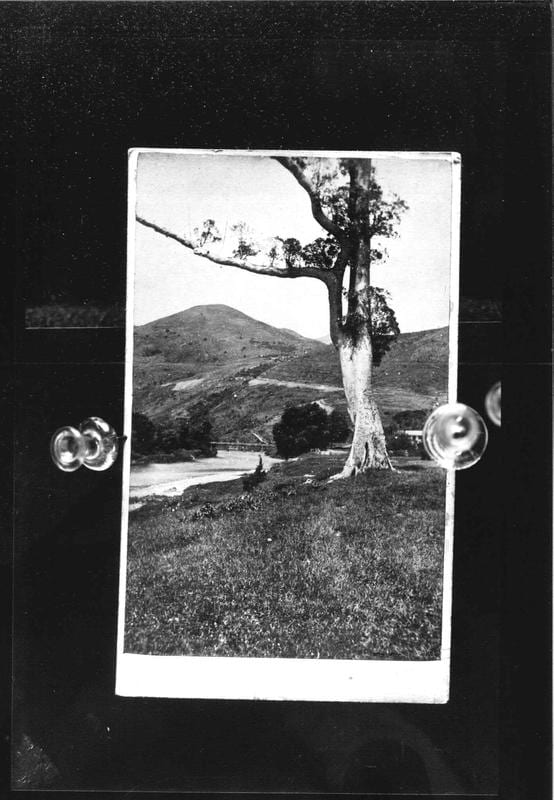
Lead writer: Brianna Vincent
Research support: Michele Leggott, Makyla Curtis

This, as someone immersed for my whole life in art, in watching my mother sketch very similar scenes around the Waikare Inlet (now I think about the impact that Edwin’s sketches hung around the Briant house might have had on her), is a fascinating account – thank you!! I also would hazard to say that the incomplete bridge looks like a rendition of what he saw – either during building or perhaps damaged (I wonder about the slightly angled pile on the left, as if impacted by something) in a flood or storm. It looks too deliberate to be an unfinished detail.
Hi Ariane, thank you so much, it’s wonderful to hear about the art ongoing in the Briant household and the legacy carrying on! And good spotting about the bridge, I think you’re right!
Wonderful work Brianna. Isn’t fun to do research?
Hi Ricci, thank you! And it really really is, I had a great time with this one